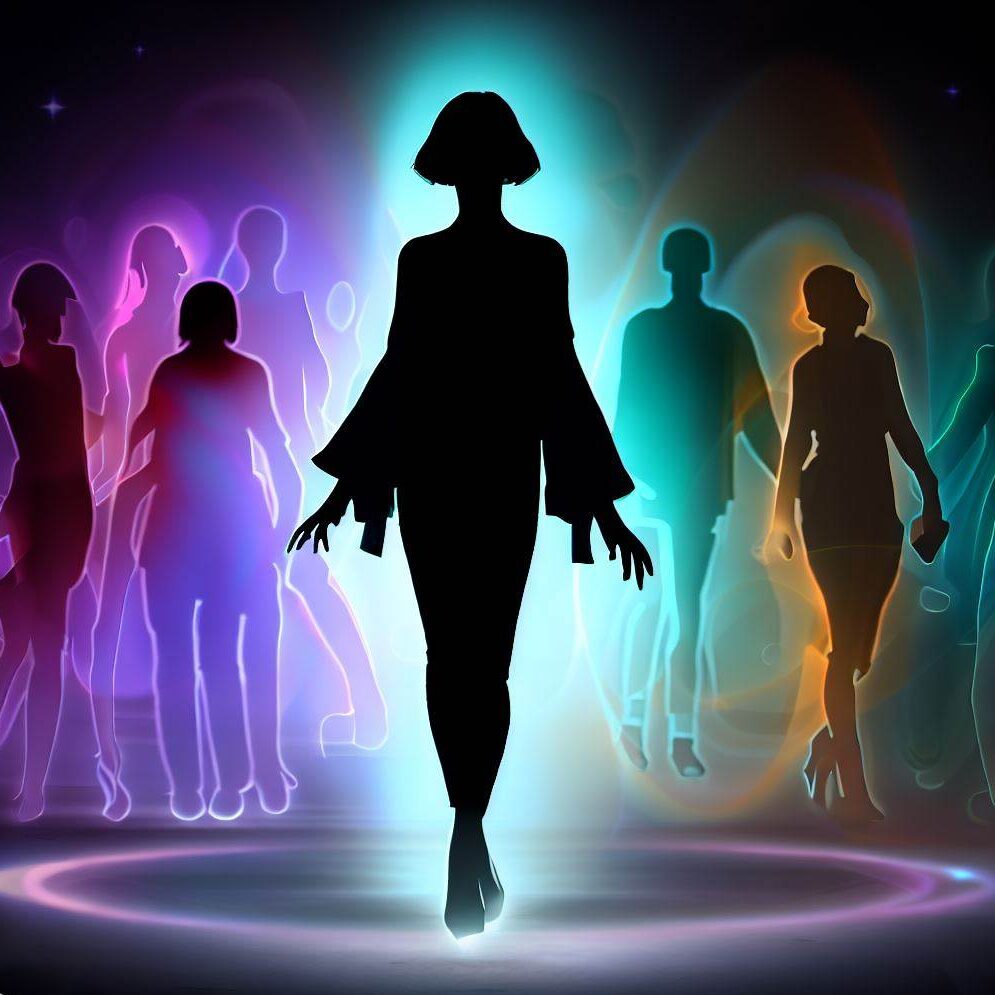
Approx. Reading time: About 18 Minutes

Introduction
Seeing, Feeling, and Interpreting the Energy Fields
Auras have fascinated spiritual seekers, healers, and metaphysical enthusiasts for centuries. These elusive energy fields surrounding living beings are believed to offer insights into our emotional, mental, and spiritual states. In this detailed article, we will explore what auras are, their spectrum of colors and interpretations, ways to see and feel auras, the movement of auras, and how to use this information. We will also touch upon important safety considerations for those venturing into the exploration of auras.

What is an Aura?
An aura is a fascinating phenomenon that encompasses the electromagnetic energy field surrounding all living beings, including humans, animals, and plants. It is considered an extension of our consciousness, intimately intertwined with our physical, emotional, mental, and spiritual aspects. Composed of subtle vibrations, the aura acts as a mirror that reflects our overall well-being on multiple levels.
At its core, the aura is an energetic manifestation of our existence, existing beyond the limitations of the physical body. It is intricately linked to the subtle energy systems that flow within and around us, such as the chakras and meridians. These energy systems play a vital role in maintaining balance and vitality in our lives.
The aura itself is an electromagnetic field, meaning it consists of electric and magnetic energies. These energies interact and intertwine, creating a multidimensional tapestry of colors, patterns, and frequencies. Everyone’s aura is unique, reflecting their essence and the energetic blueprint of their being.
The aura is not confined to a specific boundary but extends beyond the physical body. It can vary in size, influenced by factors such as emotional states, health, and spiritual development. Some auras may span a few inches, while others may encompass several feet in diameter. The fluctuations in the aura’s size can signify shifts in energy and overall vitality.
Within the aura, subtle vibrations harmonize and interplay. These vibrations reflect the interconnectedness between our physical, emotional, mental, and spiritual aspects. Auras can reveal imbalances, strengths, and areas of growth within these different facets of our being.
The colors present in the aura hold significant meaning and provide insight into our state of being. Each hue resonates with a particular energy frequency, representing various emotions, personality traits, and spiritual qualities. For instance, vibrant red may indicate passionate energy, while calming shades of blue can symbolize tranquility and spiritual depth. The combination and arrangement of colors in the aura form a unique energetic fingerprint, capturing the essence of who we are.
The aura is not static but dynamic and ever-changing. It responds to our thoughts, emotions, experiences, and overall well-being. Significant events, spiritual practices, and personal growth can influence the aura’s vibrancy, leading to shifts and transformations in its appearance.
As we delve into understanding and exploring the aura, we gain profound insights into our holistic nature. By cultivating awareness of the aura’s composition, colors, and energetic fluctuations, we unlock a deeper understanding of ourselves. The aura serves as a compass, guiding us on our journey of self-discovery, healing, and spiritual evolution.
In conclusion, the aura is an electromagnetic energy field that encapsulates our entire being. It is an expression of our consciousness and encompasses the subtle vibrations that reflect our physical, emotional, mental, and spiritual aspects. Understanding the aura grants us a unique lens to perceive and interpret our multidimensional nature, offering opportunities for growth, healing, and self-realization.
Can You See/Sense Auras?
While some individuals possess a natural ability to see and sense auras, it is believed that anyone can develop this skill through practice and increased awareness. Sensing and perceiving auras involves activating our intuitive faculties and expanding our perception beyond the physical realm. If you’re curious about whether you can see or sense auras, here are some guidelines to help you test and strengthen your abilities.
Testing Your Ability to Sense Auras:
- Self-Observation: Begin by observing yourself. Pay attention to the subtle sensations, emotions, or energetic shifts that you experience in different situations. Notice if you have a heightened sense of perception or intuitive awareness when interacting with others or being in certain environments.
- Practice with Objects: Start by focusing on inanimate objects such as plants, crystals, or even photographs. Sit in a quiet space, relax, and allow yourself to become present. Soften your gaze and gently direct your attention towards the object. Notice if you sense any energetic presence or experience subtle shifts in your perception.
- Experiment with People: Engage in exercises with a willing partner or a small group of friends. Have them stand or sit in front of a plain background, and using a relaxed gaze, observe the space surrounding them. Pay attention to any impressions, sensations, or feelings that arise. Compare your observations with the person’s self-description or ask for feedback to validate your perceptions.
Strengthening Your Ability to See and Sense Auras:
- Cultivate Mindfulness: Developing your ability to see and sense auras requires cultivating mindfulness and present-moment awareness. Engage in practices such as meditation, deep breathing exercises, or body scans to enhance your overall state of presence and receptivity.
- Clear and Balance Your Energy: Keeping your own energy field clear and balanced is essential for perceiving auras. Engage in self-care practices that support your energetic well-being, such as grounding exercises, energy cleansing techniques (e.g., smudging, bathing in saltwater), or working with healing modalities like Reiki.
- Intuitive Development: Nurture your intuition by engaging in activities that strengthen your intuitive faculties. These can include journaling, dream work, or practicing divination tools like tarot or oracle cards. Trusting and acting upon your intuitive guidance enhances your ability to sense and interpret energetic fields.
- Seek Guidance and Validation: Connect with experienced practitioners who have a deep understanding of auras and energy work. Seek their guidance, attend workshops or classes, or engage in aura reading sessions to gain insights and validation. Learning from those who have honed their skills can provide valuable guidance and support your own development.
- Patience and Practice: Developing the ability to see and sense auras requires patience and consistent practice. Engage in regular exercises, dedicate time to observation, and maintain a curious and open mindset. Celebrate even the smallest progress and trust that with perseverance, your abilities will continue to grow.
Remember, the ability to see and sense auras is a unique journey for each individual. Embrace your own unique experiences and perceptions, and don’t compare yourself to others. Trust in your innate capacity to perceive subtle energies and enjoy the exploration of the fascinating world of auras.
How to See and Feel Auras:
To embark on the journey of seeing and feeling auras, follow these practices inspired by relaxation and focus, soft gaze, peripheral vision, sensory awareness, and the importance of practice and patience:
- Relaxation and Focus: Begin by finding a quiet and comfortable space where you won’t be disturbed. Sit or lie down in a relaxed position and take a few moments to focus on your breath. Inhale deeply, allowing your abdomen to expand, and exhale fully, releasing any tension or stress. Clearing your mind of distractions through meditation or deep breathing will enhance your ability to perceive subtle energies.
- Soft Gaze: Instead of fixing your gaze directly on the person, object, or plant you wish to observe, adopt a soft gaze. Softening your focus allows you to shift your attention to the space surrounding the subject. By doing so, you may notice a gentle expansion of your field of vision, making it easier to detect the energetic field or aura.
- Peripheral Vision: Utilize your peripheral vision as you engage in aura observation. While focusing on a specific point near the person or object, maintain a wider awareness of the surrounding space. Peripheral vision is more attuned to perceiving subtle energies, and this technique can assist in detecting auras. It helps bypass the tendency to focus solely on the physical form and allows you to notice the energetic presence more readily.
- Sensory Awareness: Pay attention to subtle sensations and shifts in energy as you focus on the subject. Allow your intuitive impressions and feelings to guide you. You may experience tingling, warmth, coolness, or a sense of pressure in different parts of your body. Trust these sensory cues, as they can provide valuable insights into the energetic field you are observing.
- Practice and Patience: Developing the ability to see and feel auras requires consistent practice and patience. Treat aura observation as a skill that improves with time and effort. Engage in regular sessions where you dedicate focused time to observe and sense auras. Even if you don’t perceive anything immediately, remember that each session contributes to your overall progress. Be patient with yourself and avoid placing unnecessary pressure or expectations on the outcome.
- Journaling and Reflection: Maintaining a journal can be a valuable tool to document your experiences, observations, and insights during aura practices. After each session, take a few moments to reflect on your perceptions, any sensations, or impressions you noticed, and how they made you feel. This reflection will deepen your understanding, enhance your self-awareness, and allow you to track your progress over time.
- Seek Support and Validation: Engaging with others who share an interest in auras can provide guidance, support, and validation for your experiences. Joining spiritual or metaphysical communities, attending workshops or classes, or connecting with experienced practitioners can offer valuable insights and a sense of community. Sharing your journey and learning from others who have developed their abilities can inspire and accelerate your progress.
In conclusion, seeing and feeling auras requires relaxation, focus, soft gaze, peripheral vision, sensory awareness, and consistent practice. By incorporating these techniques into your routine, you can begin to perceive and connect with the subtle energetic fields that surround living beings. Remember to approach your journey with patience, trust in your intuitive impressions, and maintain a sense of curiosity and open-mindedness. Enjoy the process of expanding your perception and deepening your connection to the vibrant tapestry of energy that surrounds us all.
The Spectrum of Colors and Their Meanings:
Auras are frequently described in terms of colors, and each hue within the aura carries its own unique significance. The colors within an aura provide valuable insights into a person’s emotional state, personality traits, and spiritual aspects. Here are some common aura colors and their interpretations:
- Red: Red within an aura signifies passion, vitality, and strong emotions. It represents a person’s intense energy, enthusiasm, and desire for action. A vibrant red hue often indicates a passionate individual with a zest for life and a strong will.
- Orange: Orange in an aura is associated with creativity, enthusiasm, and joy. It represents a person’s vibrant and playful nature, indicating a zest for life and a sense of adventure. Individuals with a predominant orange aura are often creative, spontaneous, and expressive.
- Yellow: Yellow within an aura symbolizes intellect, optimism, and a vibrant personality. It reflects mental clarity, positivity, and an analytical mindset. Those with a yellow aura are often intelligent, cheerful, and possess a natural curiosity and thirst for knowledge.
- Green: Green in an aura signifies healing, growth, and balance. It represents a person’s connection to nature, compassion, and harmony. A strong presence of green often indicates a nurturing and empathetic individual with a deep love for the environment and a natural ability to support and heal others.
- Blue: The color blue within an aura is associated with calmness, spirituality, and effective communication. It represents a person’s serenity, spiritual awareness, and ability to express themselves with clarity. Individuals with a blue aura are often spiritually inclined, intuitive, and have a calm and soothing presence.
- Indigo: Indigo in an aura represents intuition, deep insight, and spiritual awareness. It reflects a person’s ability to tap into their inner wisdom, heightened perception, and connection to the higher realms. Those with an indigo aura are often gifted with psychic abilities, possess profound spiritual knowledge, and exhibit a strong sense of purpose.
- Violet: Violet within an aura symbolizes wisdom, spiritual connection, and heightened consciousness. It represents a person’s spiritual growth, enlightenment, and connection to divine energies. Individuals with a predominant violet aura are often spiritually advanced, possess profound wisdom, and radiate a sense of inner peace and tranquility.
It’s important to note that these interpretations are general guidelines, and the colors within an aura can vary in intensity, combination, and placement. Additionally, the presence of multiple colors within an aura further adds depth and complexity to its interpretation. Trust your intuition and consider the overall energy and combination of colors to gain a more comprehensive understanding of the person’s aura and its meanings.
Understanding the spectrum of colors within an aura allows us to gain deeper insights into ourselves and others, fostering self-awareness, empathy, and spiritual growth. By paying attention to these colors, we can enhance our understanding of the energetic tapestry that surrounds us and deepen our connections with the vibrant spectrum of human experiences.
Interpreting Auras:
Interpreting auras is a captivating and intuitive process that involves considering multiple factors, including color, intensity, size, and location. It’s crucial to recognize that interpretations can be subjective and may vary from person to person. Trusting your intuition and observing patterns over time will assist in developing a deeper understanding of aura interpretations.
- Color: Colors play a significant role in aura interpretation. Each hue within an aura holds its own energetic significance. Referencing the common meanings associated with different colors, as mentioned earlier, can provide a starting point for understanding auras. However, it’s important to note that individual experiences and cultural associations may influence personal interpretations. Trusting your intuitive sense and observing how colors resonate with the person’s overall energy and presence will help refine your understanding.
- Intensity: The intensity or brightness of colors within an aura provides additional insights. A strong, vibrant color may indicate an amplified expression of the associated traits or emotions. Conversely, a muted or dull color might suggest a temporary suppression or depletion of those energies. Observing the intensity can reveal the strength and vitality of different aspects of a person’s being.
- Size: The size of an aura can vary, reflecting the energetic presence and expansion around an individual. A larger aura generally indicates a more expansive, outgoing, or energetically open personality. It suggests that the person is actively engaged with their environment and possesses a higher level of vitality. Conversely, a smaller aura might suggest introversion, reserve, or a need for energetic restoration. Consider the context, the person’s temperament, and any variations in aura size observed over time.
- Location: The location of colors within the aura can offer valuable insights into specific aspects of a person’s life and being. For instance, if a particular color is concentrated around the head region, it may indicate a strong intellectual or spiritual focus. Colors near the heart might suggest emotional qualities or a compassionate nature. Pay attention to any patterns or concentration of colors in specific areas to understand how they correspond to the person’s experiences and characteristics.
- Trusting Intuition and Observing Patterns: Interpreting auras is a deeply intuitive process, and it is essential to trust your instincts and personal impressions. While general interpretations and associations with colors can provide a foundation, your intuition will guide you in understanding the unique nuances and complexities of each aura. Observe patterns and correlations between colors, intensity, size, and location over multiple interactions to develop a deeper understanding of the person’s energetic makeup.
It’s important to approach aura interpretation with an open mind and an understanding that it is a dynamic and evolving practice. Each person’s aura is unique, and interpretations can vary based on individual experiences, cultural influences, and personal perspectives. Embrace the journey of exploring and understanding auras, allowing your intuition to be your guide, and observing the patterns that unfold over time. Through continuous practice, observation, and trust in your intuitive faculties, you will develop a profound understanding of aura interpretations and unlock the insights they offer for self-discovery and connection with others.
The Way Auras Can Appear:
Auras are not confined to a single appearance but can manifest in various ways, offering unique insights into a person’s energetic field. Understanding the different manifestations of auras enhances our ability to perceive and interpret these subtle energy fields. Here are some common ways in which auras can appear:
- Subtle Mist-Like Field: One of the common manifestations of an aura is a subtle, mist-like field surrounding the body. This misty appearance often extends a few inches to a few feet beyond the physical form. It may appear as a delicate, ethereal layer that emanates from the person. The mist-like aura is often described as having a soft, translucent quality, with colors and energy subtly blending.
- Bands or Layers of Energy: Auras can also manifest as bands or layers of energy extending outward from the body. These bands or layers represent different aspects of the person’s energy and can vary in thickness and intensity. The bands may appear as distinct rings or ribbons encircling the body, each carrying its own unique color or vibration. Observing these layers can provide insights into the multifaceted nature of an individual’s being.
- Varying Degrees of Intensity and Brightness: Auras can exhibit varying degrees of intensity and brightness. Some auras may radiate with a vibrant and luminous glow, indicating a strong and vibrant energy field. Others may appear more subdued or muted, suggesting a temporary depletion or a calmer state of being. The intensity and brightness of an aura can provide clues about a person’s vitality, emotional state, and overall energy levels.
- Distinct Shapes or Patterns: Within the aura, distinct shapes or patterns may emerge. These can include geometric forms, such as circles, squares, or triangles, or more intricate patterns like spirals or waves. Some individuals may have specific symbols or images appearing within their aura, representing significant aspects of their life or spiritual journey. Paying attention to these shapes or patterns can offer deeper insights into a person’s energetic composition and experiences.
It’s important to note that auras are highly subjective and can vary from person to person. The way an aura appears may be influenced by the observer’s sensitivity, perception, and the level of energetic attunement. Each person’s aura is unique and may be presented in a way that resonates with their individual energy and experiences.
As you explore and observe auras, maintain an open and curious mindset. Allow yourself to be receptive to the diverse ways in which auras can manifest. Trust your intuition and observations, recognizing that interpretations may vary and that the true understanding of an aura goes beyond its physical appearance. Embrace the beauty and intricacies of these energetic fields as you deepen your connection to the vibrant tapestry of human energy and consciousness.
The Movement of Auras and Its Significance:
Auras are not static entities but dynamic fields of energy, constantly in motion. The movements observed within an aura can provide valuable insights into the energetic state and experiences of an individual. Understanding the significance of aura movement enhances our ability to interpret and connect with the ever-changing nature of these energetic fields. Here are some common movements observed in auras and their interpretations:
- Expansion and Contraction: The movement of expansion and contraction within an aura reflects the openness or defensiveness of a person’s energy. An expanding aura signifies a state of openness, receptivity, and an outgoing nature. It suggests a willingness to engage with the world and an embracing of new experiences. In contrast, a contracting aura indicates a more self-protective or introverted state. It may reflect a need for personal space, boundaries, or a withdrawal from external stimuli.
- Vibrations or Shimmering: Vibrations or shimmering movements within an aura indicate heightened states of emotion or spiritual energy. It signifies an increase in the intensity and frequency of energy flow within the aura. These movements may be observed as subtle ripples or waves that traverse through the energy field. Vibrations or shimmering suggest the presence of strong emotions, spiritual awakenings, or moments of deep insight and connection.
- Spiraling or Swirling: Spiraling or swirling movements within an aura suggest active transformation or the release of energy. These movements can be observed as spiraling patterns or energetic currents moving in a circular or swirling motion within the aura. It signifies a dynamic process of change, growth, or the shedding of old patterns. Spiral or swirling movements indicate a person’s readiness for personal transformation, renewal, or the release of stagnant energies.
The Direction of Movement:
The direction of movement within an aura also holds significance. Movement from the head to the toes is often associated with grounding. It suggests the flow of energy from the higher chakras down to the lower chakras, promoting stability, rootedness, and a connection to the physical realm. Grounding movement assists in balancing and anchoring a person’s energy, fostering a sense of stability and security.
Conversely, movement from the toes to the head is uplifting. It signifies the upward flow of energy from the lower chakras to the higher chakras. This movement promotes spiritual growth, expansion of consciousness, and a connection to higher realms. Uplifting movement facilitates the alignment of one’s energy with higher frequencies, inspiring a sense of upliftment, inspiration, and spiritual connection.
Interpreting Aura Movement:
Interpreting aura movement requires attentiveness and intuitive awareness. It is important to observe the context, overall energy, and patterns of movement over time. Trust your intuition and allow the movements to guide your interpretation, understanding that individual experiences may vary. Remember that movement within an aura reflects the dynamic nature of energy and consciousness. Embrace the fluidity and ever-changing essence of auras as you deepen your understanding and connection to the vibrant tapestry of energetic existence.
How to Use Aura Information:
Understanding auras and their significance can unlock a wealth of insights that contribute to personal growth, healing, and enhanced interpersonal relationships. By harnessing the information present in auras, we can make positive changes in ourselves and deepen our connections with others. Here are some ways to utilize aura information:
- Self-Reflection and Healing: Awareness of our own aura allows us to gain deeper insights into our energetic state and overall well-being. By regularly observing and interpreting our aura, we can identify imbalances, areas of growth, and patterns that require attention. This awareness opens the door for personal reflection, self-healing, and transformation. It enables us to take proactive steps to restore harmony and balance in our physical, emotional, mental, and spiritual aspects.
- Energy Alignment and Clearing: Aura information serves as a compass for aligning our energy with our highest potential. By understanding the colors, movements, and intensity within our aura, we can discern where energy blockages or disharmony may reside. This insight empowers us to engage in energy-clearing practices such as meditation, energy healing modalities, or mindfulness techniques that promote the free flow of energy and support our overall well-being.
- Relationship Dynamics: Interpreting the auras of others can provide valuable cues about their emotional well-being and help us navigate interpersonal relationships. Observing changes in someone’s aura color, intensity, or movement can give us insight into their current state and experiences. This understanding fosters empathy, compassion, and a deeper level of connection. It allows us to offer support, understanding, and tailored communication approaches based on the energy we perceive within their aura.
- Enhancing Communication: Aura information can enrich our communication with others. By being attuned to the energetic cues within someone’s aura, we can pick up on unspoken emotions, underlying energy patterns, or shifts in their energetic field. This awareness enables us to respond with greater sensitivity, understanding, and empathy, fostering effective and meaningful communication.
- Facilitating Healing and Support: Interpreting the auras of others also empowers us to provide healing and support. By recognizing imbalances or areas of disharmony within someone’s aura, we can offer guidance, healing modalities, or resources that may assist in their well-being. Understanding the energetic aspects of their being allows us to tailor our support to their specific needs, promoting their healing and growth.
Remember, utilizing aura information is a dynamic and intuitive process. It requires ongoing practice, trust in your intuitive senses, and open-mindedness. As you engage with aura information, respect the boundaries and consent of others. Use this knowledge as a tool for personal growth, healing, and fostering positive connections with those around you. The understanding and utilization of aura information has the potential to enhance our overall well-being, deepen our relationships, and contribute to a more harmonious and connected existence.
Safety Considerations:
While exploring auras can be a fascinating and insightful practice, it is crucial to approach it with respect, integrity, and consideration for personal boundaries. Here are some important safety considerations to keep in mind when engaging with auras:
- Consent: Obtaining consent is of utmost importance when working with auras. Always seek permission before attempting to read or interpret someone’s aura. Respect their autonomy and personal boundaries. Not everyone may be comfortable with having their aura observed or discussed, so ensure that you have explicit permission before proceeding. Honor their choice if they decline or express discomfort.
- Sensitivity and Confidentiality: Aura reading is a subjective experience, and interpretations can vary. When offering insights or interpretations of someone’s aura, do so with sensitivity and care. Remember that the information shared is personal and may be deeply meaningful to the individual. Respect their privacy and maintain confidentiality by refraining from sharing their aura details without their explicit consent.
- Non-Intrusiveness: Respect the energetic boundaries of others. Be mindful of the space and energy you bring into aura observation. Avoid intrusive or invasive actions, both physically and energetically. It is important to maintain a sense of respect, empathy, and ethical conduct throughout the process.
- Personal Well-being: Prioritize your own well-being and energetic hygiene when engaging with auras. Grounding, cleansing, and protecting your own energy field before and after aura-related practices can help maintain a balanced and healthy state. Establish personal boundaries and listen to your intuition regarding the amount of energy and time you invest in aura exploration.
- Ethical Considerations: Approach aura work with integrity and ethical considerations. Recognize that aura information is deeply personal and should be used responsibly and respectfully. Do not exploit or manipulate others based on the information gained from their aura. Use your insights and interpretations to foster healing, understanding, and support rather than to exert control or dominance.
- Continuous Learning: Maintain a mindset of continuous learning and growth in your understanding of auras. Seek out reputable sources, mentors, or practitioners who can provide guidance and expand your knowledge. Engaging in ethical discussions and staying informed about the evolving field of aura study can contribute to a safer and more responsible practice.
By adhering to these safety considerations, we can engage in aura exploration with empathy, respect, and integrity. The practice of understanding auras can be a transformative and enlightening journey when approached ethically and responsibly. Remember, the well-being and consent of individuals should always be prioritized, fostering an environment of trust, respect, and growth.
Conclusion:
Auras offer us a profound glimpse into the intricate tapestry of subtle energies that surrounds and interconnects all living beings. Developing the ability to perceive and interpret auras opens a gateway to self-discovery, empathy, and spiritual growth. By honing our skills to see and feel auras, we embark on a journey of profound insights and connections with ourselves and others. Through careful observation, sensitive interpretation, and compassionate understanding, the exploration of auras becomes a transformative tool for personal growth, healing, and an ever-deepening connection with the expansive and vibrant energetic fabric that weaves together the universe. Embrace the world of auras, and let the journey unfold, igniting a deeper understanding of ourselves, the world around us, and the boundless realm of energy that exists within and beyond our perception.











